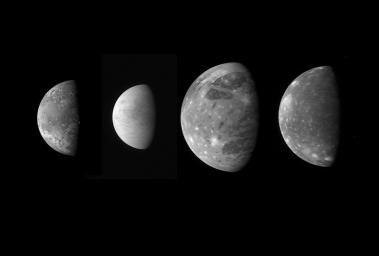
|
Jupiter’s Moons: Family Portrait
- Click the image above for a larger view
- Full-Res JPEG (3000 x 2025) (180.2 kB)
- Full-Res TIFF (3000 x 2025) (6.1 MB)
Caption:
This montage shows the best views of Jupiter's four large and diverse "Galilean" satellites as seen by the Long Range Reconnaissance Imager (LORRI) on the New Horizons spacecraft during its flyby of Jupiter in late February 2007. The four moons are, from left to right: Io, Europa, Ganymede and Callisto. The images have been scaled to represent the true relative sizes of the four moons and are arranged in their order from Jupiter.
Io, 3,640 kilometers (2,260 miles) in diameter, was imaged at 03:50 Universal Time on February 28 from a range of 2.7 million kilometers (1.7 million miles). The original image scale was 13 kilometers per pixel, and the image is centered at Io coordinates 6 degrees south, 22 degrees west. Io is notable for its active volcanism, which New Horizons has studied extensively.
Europa, 3,120 kilometers (1,938 miles) in diameter, was imaged at 01:28 Universal Time on February 28 from a range of 3 million kilometers (1.8 million miles). The original image scale was 15 kilometers per pixel, and the image is centered at Europa coordinates 6 degrees south, 347 degrees west. Europa's smooth, icy surface likely conceals an ocean of liquid water. New Horizons obtained data on Europa's surface composition and imaged subtle surface features, and analysis of these data may provide new information about the ocean and the icy shell that covers it.
New Horizons spied Ganymede, 5,262 kilometers (3,268 miles) in diameter, at 10:01 Universal Time on February 27 from 3.5 million kilometers (2.2 million miles) away. The original scale was 17 kilometers per pixel, and the image is centered at Ganymede coordinates 6 degrees south, 38 degrees west. Ganymede, the largest moon in the solar system, has a dirty ice surface cut by fractures and peppered by impact craters. New Horizons' infrared observations may provide insight into the composition of the moon's surface and interior.
Callisto, 4,820 kilometers (2,995 miles) in diameter, was imaged at 03:50 Universal Time on February 28 from a range of 4.2 million kilometers (2.6 million miles). The original image scale was 21 kilometers per pixel, and the image is centered at Callisto coordinates 4 degrees south, 356 degrees west. Scientists are using the infrared spectra New Horizons gathered of Callisto's ancient, cratered surface to calibrate spectral analysis techniques that will help them to understand the surfaces of Pluto and its moon Charon when New Horizons passes them in 2015.
Cataloging Keywords:
| Name | Value | Additional Values |
|---|---|---|
| Target | Jupiter | Callisto, Charon, Europa, Ganymede, Io |
| System | Jupiter | |
| Target Type | Planet | Satellite |
| Mission | New Horizons | |
| Instrument Host | New Horizons | |
| Host Type | Flyby Spacecraft | |
| Instrument | Long Range Reconnaissance Imager (LORRI) | |
| Detector | ||
| Extra Keywords | Crater, Grayscale, Impact, Infrared, Moon, Visual, Volcano, Water | |
| Acquisition Date | ||
| Release Date | 2007-05-01 | |
| Date in Caption | ||
| Image Credit | NASA/Johns Hopkins University Applied Physics Laboratory/Southwest Research Institute | |
| Source | photojournal.jpl.nasa.gov/catalog/PIA09352 | |
| Identifier | PIA09352 | |
